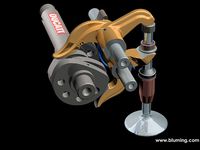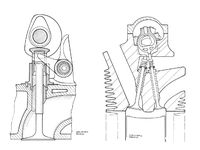Word in the MotoGP paddock is that rival engineers are starting to realize the advantages of Ducati's desmodromic valve system may exist on several levels. The Desmosedici GP7s of Casey Stoner and Loris Capirossi were the fastest bikes on the track all year, but speed is only part of the story. Because bikes with more efficient engines can finish a race at full power, Ducati has often had an advantage, while competitors often ran out of fuel or finish on reduced power. Nicky Hayden wasn't losing positions late in races due to overcooked tires, but because his Honda RC212V's engine-management system was limiting fuel use by cutting power.
There are three types of valve gear currently employed in MotoGP. Systems with metal valve springs and pneumatic (air) valve springs must use engine power to open the valves against the high pressure of these springs, designed to cope with the near-20,000-rpm rev limits. Desmodromic valve gear, which opens and closes the valves via cams and rocker arms, uses less power controlling the valves and is an inherently more effi cient design.
The competition may be forced to consider desmodromic systems of their own in order to match the Desmosedici's pace and fuel efficiency. But isn't Desmo a Ducati exclusive? I knew the Italian manufacturer hadn't been the only one to use such a system, but a little research uncovered some real surprises...
The word itself comes from the Greek desmos (controlled) and dromos (track), combined to describe a system in which the full cycle of the valve is controlled mechanically, without springs. Inventions date back to the early 20th century, when valve springs were notoriously unreliable. To make good power, designers wanted to use overhead valves, rather than side valves, because of the much better port and combustion chamber shapes they allowed. Break a valve spring in a side-valve or flathead engine and the valve just stays there. But break one in an OHV engine and it falls into the combustion chamber, hits the piston, and you're lucky if the engine isn't destroyed.
The valve spring was the Achilles heel of the early OHV engine, and many inventors worked tirelessly to eliminate the possibility of a broken spring ruining an engine. How many inventors? Dozens. Among those auto manufacturers that have use or researched desmodromic systems are Mercedes, Porsche, Fiat, Delage, Cosworth, BRM, Osca, Maserati and Ferrari. The list of motorcycle builders is just as impressive: JAP, Velocette, Neander, Benelli, Moto Guzzi, MV Agusta, Norton, BMW and, of course, Ducati.
For a fascinating look at the development of desmodromic valve systems, pay a visit to the website put together by Henk Cloosterman and Francisco Klaren of the Netherlands (). They divide the various systems into 11 groups and 17 categories, most of which have several applications. They've built models representing each group, and there are photos, patent applications, illustrations...right down to the inventors' sketches.
There is a fascinating progression in the goals of these inventors over the decades. First it was to build OHV engines with reliability. As metallurgical research and improvements in manufacturing techniques made valve springs that could last nearly indefinitely in production engines, research shifted to high-performance, high-rpm applications where springs were still stressed near failure, and desmodromics were seen as a way to prevent valve float. Today, specialized valve springs with oval wire, "beehive" winding shapes, flat wire and extraordinarily pure metal processing have made it possible to achieve extreme performance with metal springs. Meanwhile, pneumatic valve springs first appeared in Formula 1 and are now being used in MotoGP by Kawasaki, Suzuki and Yamaha. As a result, desmodromic research has moved to preventing the waste of energy involved in the compression of springs.
One way the MotoGP organizers could reduce Ducati's advantage would be to increase fuel capacity, because the engines are all capable of making more power and more rpm if they have more fuel. But with the current rules, and with all the engines using almost every conceivable avenue to effi ciency, desmodromic valve gear is a clear and defining advantage.













/cloudfront-us-east-1.images.arcpublishing.com/octane/VZZXJQ6U3FESFPZCBVXKFSUG4A.jpg)
/cloudfront-us-east-1.images.arcpublishing.com/octane/QCZEPHQAMRHZPLHTDJBIJVWL3M.jpg)
/cloudfront-us-east-1.images.arcpublishing.com/octane/HXOUJXQWA5HBHGRO3EMJIGFMVI.jpg)

/cloudfront-us-east-1.images.arcpublishing.com/octane/3TIWWRV4JBBOLDVGRYECVVTA7Y.jpg)
/cloudfront-us-east-1.images.arcpublishing.com/octane/KIX5O23D5NAIBGFXBN3327DKZU.jpg)
/cloudfront-us-east-1.images.arcpublishing.com/octane/7GJYDUIPXRGMTMQKN6ONYOLBOU.jpg)
/cloudfront-us-east-1.images.arcpublishing.com/octane/MUQLOVLL2ZDGFH25ILABNBXKTI.jpg)
/cloudfront-us-east-1.images.arcpublishing.com/octane/TNOU5DNE2BC57MFPMGN2EIDXAM.jpg)
/cloudfront-us-east-1.images.arcpublishing.com/octane/GTCXACQGJ5HAPDTGWUQKDEH44E.jpg)
/cloudfront-us-east-1.images.arcpublishing.com/octane/S35YGSEMEZB4BLTDJTSZPF4GLA.jpg)
/cloudfront-us-east-1.images.arcpublishing.com/octane/5UOT6HPX2JFMRJAX6EH45AR4MQ.jpg)
/cloudfront-us-east-1.images.arcpublishing.com/octane/OKWOJWAKP5EP3OACCRRWPCIX2Q.jpg)
/cloudfront-us-east-1.images.arcpublishing.com/octane/2WF3SCE3NFBQXLDNJM7KMXA45E.jpg)
/cloudfront-us-east-1.images.arcpublishing.com/octane/G4MG6OUCJNBSHIS2MVVOTPX65E.jpg)
/cloudfront-us-east-1.images.arcpublishing.com/octane/IIGGWFOTOJGB7DB6DGBXCCMTDY.jpg)
/cloudfront-us-east-1.images.arcpublishing.com/octane/QSTCM6AVEZA5JJBUXNIQ3DSOF4.jpg)
/cloudfront-us-east-1.images.arcpublishing.com/octane/U4I7G625B5DMLF2DVIJDFZVV6M.jpg)
/cloudfront-us-east-1.images.arcpublishing.com/octane/B6XD6LS6IVCQPIU6HXDJSM3FHY.jpg)
/cloudfront-us-east-1.images.arcpublishing.com/octane/ICL63FEDDRDTTMINYICCEYGMDA.jpg)
/cloudfront-us-east-1.images.arcpublishing.com/octane/FCGZHQXRBZFLBAPC5SDIQLVF4I.jpg)
/cloudfront-us-east-1.images.arcpublishing.com/octane/WNOB6LDOIFFHJKPSVIWDYUGOPM.jpg)

/cloudfront-us-east-1.images.arcpublishing.com/octane/X33NU3E525ECRHXLNUJN2FTRKI.jpg)